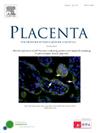Cardiovascular health in early pregnancy and circulating placental biomarkers
IF 2.5
2区 医学
Q2 DEVELOPMENTAL BIOLOGY
引用次数: 0
Abstract
Background
Maternal cardiovascular and placental health are related to pregnancy outcomes, yet how cardiovascular health (CVH) in early pregnancy affects placentation is not well characterized. Our objective was to estimate associations between CVH and concentrations of placental proteins. We hypothesized that more favorable CVH metrics would be associated with more favorable circulating concentrations of pregnancy-associated plasma protein A (PAPP-A), vascular endothelial growth factor (VEGF), placental growth factor (PlGF), soluble FMS-like tyrosine kinase 1 (sFlt-1), and soluble endoglin (sEng) in the 1st and 2nd trimesters.
Methods
Participants from the nuMoM2b prospective cohort with valid biomarker measures were included (n = 2188). Maternal CVH was defined using the American Heart Association's Life's Essential 8 composite score, averaging six components measured in the 1st trimester: body mass index (BMI), blood pressure, physical activity, diet, sleep duration, and smoking. Individual component scores were also evaluated. Linear regression associated scores with 1st and 2nd trimester circulating placental biomarkers.
Results and conclusions
Higher (more favorable) composite CVH scores were associated with higher PAPP-A (favorable) in both trimesters. In contrast, higher CVH scores were associated with lower VEGF, higher sFlt-1, and higher sEng in the 1st trimester (adverse). Healthier BMI scores demonstrated similar associations as those found with composite CVH. Greater physical activity was associated with more favorable 1st trimester profiles (higher VEGF and lower sFlt-1), but lower 2nd trimester PAPP-A. Composite CVH, potentially driven by BMI and physical activity components, may be an important factor relating to circulating concentrations of placental biomarkers in the first half of pregnancy.
妊娠早期心血管健康与循环胎盘生物标志物
背景:母体心血管和胎盘健康与妊娠结局相关,但妊娠早期心血管健康(CVH)如何影响胎盘发育尚不清楚。我们的目的是估计CVH和胎盘蛋白浓度之间的关系。我们假设更有利的CVH指标与妊娠相关血浆蛋白A (PAPP-A)、血管内皮生长因子(VEGF)、胎盘生长因子(PlGF)、可溶性fms样酪氨酸激酶1 (sFlt-1)和可溶性内啡肽(sEng)在妊娠第一和第二三个月更有利的循环浓度相关。方法:纳入来自具有有效生物标志物测量的nuMoM2b前瞻性队列的参与者(n = 2188)。孕妇CVH的定义采用美国心脏协会的生命基本8综合评分,在妊娠早期测量的六个组成部分的平均值:体重指数(BMI)、血压、身体活动、饮食、睡眠时间和吸烟。个别成分得分也进行了评估。线性回归将评分与妊娠早期和晚期循环胎盘生物标志物联系起来。结果和结论:较高(更有利)的CVH综合评分与较高的pap - a(有利)在两个妊娠期相关。相反,较高的CVH评分与妊娠早期较低的VEGF、较高的sFlt-1和较高的sEng相关(不良)。较健康的BMI评分与复合CVH的结果有相似的关联。更大的体力活动与更有利的妊娠早期特征(较高的VEGF和较低的sFlt-1)相关,但与较低的妊娠中期PAPP-A相关。复合CVH可能由BMI和身体活动成分驱动,可能是与妊娠前半期胎盘生物标志物循环浓度相关的重要因素。
本文章由计算机程序翻译,如有差异,请以英文原文为准。
求助全文
约1分钟内获得全文
求助全文
来源期刊

Placenta
医学-发育生物学
CiteScore
6.30
自引率
10.50%
发文量
391
审稿时长
78 days
期刊介绍:
Placenta publishes high-quality original articles and invited topical reviews on all aspects of human and animal placentation, and the interactions between the mother, the placenta and fetal development. Topics covered include evolution, development, genetics and epigenetics, stem cells, metabolism, transport, immunology, pathology, pharmacology, cell and molecular biology, and developmental programming. The Editors welcome studies on implantation and the endometrium, comparative placentation, the uterine and umbilical circulations, the relationship between fetal and placental development, clinical aspects of altered placental development or function, the placental membranes, the influence of paternal factors on placental development or function, and the assessment of biomarkers of placental disorders.
 求助内容:
求助内容: 应助结果提醒方式:
应助结果提醒方式:


